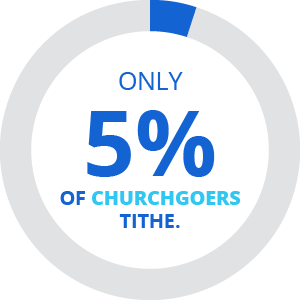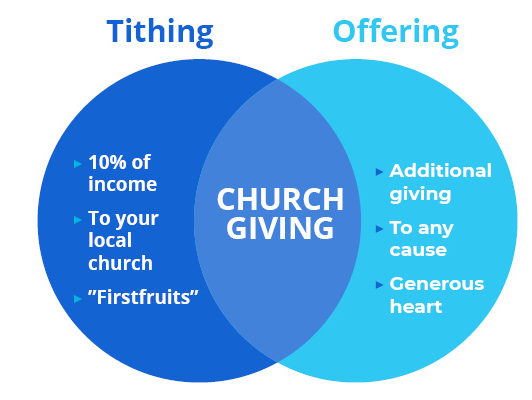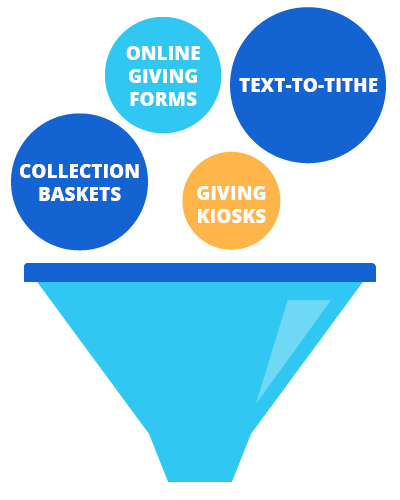New technology has revolutionized churches. From the way congregants relate to one another to the processes involved in hosting a church service, and even to how we read the Bible, almost every aspect of our lives have been impacted by the digital age. Why should church giving be any different?
You’ve likely heard of text-to-give fundraising— a popular technologically-driven method for gathering donations with just a few taps on a smartphone. Nonprofits and other charitable organizations have seen huge successes with this fundraising strategy. And here’s the best part: so can churches!
Tithing is an important practice in most Christian churches, and yet according to a 2018 study, only about 5% of churchgoers actually tithe. While the reasoning behind this statistic surely varies, one can assume that a significant factor is inconvenience— whether that’s writing a check or remembering to carry cash every Sunday.
That’s where text-to-tithe comes in! By providing a simple, fast, and convenient way to give (requiring nothing but a cell phone and a credit card number), churches that implement this unique strategy begin to see substantial revenue increases.
That’s why we’ve put together this comprehensive guide to fully explore new giving opportunities and note any room for future growth. We’ll walk you through the following topics:
- Online Giving and Text-to-Tithe for Churches: FAQ
- Text-to-Tithe Tips for Successful Implementation
- Choosing the Best Text-to-Tithe Software
Let’s get started with strengthening your understanding of online church giving solutions and, specifically, the text-to-tithe process.
Online Giving and Text-to-Tithe for Churches: FAQ
Before we jump into the text-to-tithe process, there are a few frequently asked questions about general online giving practices for churches like yours. Whether you’re a sizable congregation that’s fairly in-the-know about church technology or a long-standing local church that tends to do things the “old-school” way, this guide can help. Let’s explore the following questions:
What are the main types of church giving?
Generally speaking, church giving encompasses any contributions one might make to a local church— whether that’s putting a few dollars in the offering plate as it’s passed around on Sunday morning or sponsoring a student planning on an international mission trip.
However, most church giving tends to fall into one of the following categories:
- Tithing: Tithing literally means “a tenth.” That is, tithing is the practice of giving 1/10 of your income to the church. Although there is some ambiguity surrounding the specifics (such as, “Am I supposed to tithe according to my gross or net income?”), most agree that to be considered a tithe, it must be 10% or more.
- Offering: While tithing tends to come with certain strings attached, offerings are more open and inclusive. An offering is seen as a “bonus gift,” often going above and beyond the required 10% for a tithe. However, churchgoers who choose not to tithe may opt to participate in church offerings instead.
As far as text-to-tithe goes, churchgoers can use such mobile giving tools to contribute in any way they feel called—whether that be a tithe or an offering.
What is the purpose of tithing?
Tithing has been a long-kept religious practice, going back as early as 1400 B.C. While this was originally a Jewish tradition, tithing has carried over into the Christian faith to give back to both God and the church. As a church leader, you likely already have a solid understanding of tithing practices.
However, here are a few verses that can boost your knowledge and provide a framework you can share with your congregation as well:
- Genesis 28:20–22: Then Jacob made a promise. He said, “If God will be with me and take care of me as I go, and if He will give me food to eat and clothes to wear so that I return in peace to my father’s house, then the Lord will be my God. I have set up this stone as a pillar to be God’s house. And I will give You a tenth part of all You give to me.”
- Proverbs 3:9–10: Honor the Lord with your riches, and with the first of all, you grow. Then your store-houses will be filled with many good things, and your barrels will flow over with new wine.
- 2 Corinthians 9:6-8: Remember this: Whoever sows sparingly will also reap sparingly, and whoever sows generously will also reap generously. Each of you should give what you have decided in your heart to give, not reluctantly or under compulsion, for God loves a cheerful giver. And God can bless you abundantly, so that in all things at all times, having all that you need, you will abound in every good work.
The bottom line that is consistently present between these verses is that giving should be done with a generous heart and a grateful spirit. While originally a Jewish law requirement, many churchgoers believe that tithing instead should be an act of good faith and free will. As a display of trust and honor, congregants contribute a portion of their incomes to support the church’s mission.
How do churches use tithes?
One prevalent question among churchgoers is, “What exactly do churches do with the money we tithe?” If your congregation is unsure of where their hard-earned money is going, or they believe it’s not being used responsibly, they’re unlikely to contribute. That’s why ensuring transparency between the leadership team and their congregation is crucial for maximizing church giving.
Although the specifics will vary from one location to the next, much of a church’s budget is spent in one of these three categories:
- Salaries: A large percentage of collected tithes and offerings tends to go towards paying the salaries of church employees. Depending on the church’s size and organization, this can include the pastor(s), worship leader(s), administrative staff, janitorial team, and more.
- Operations: Operating expenses such as mortgage/rent and other facility fees, as well as basic utilities like air, water, and electricity are important for keeping the church running— and the congregation happy!
- Outreach: A final portion of tithing proceeds may support any additional community outreach programs in place, although some churches may collect a separate offering for those funds. This may include projects like a youth program, food pantry or soup kitchen, or community service.
One practical way to ensure financial transparency and accountability is by making your church budget available to the public— or at least your church members. This way, congregants can see that their contributions are being put to good use and continue to give in new and exciting ways!
What is text-to-tithe, and why does it matter?
Digital tithing is a relatively new technology-based giving strategy. It’s a catch-all term that can include methods such as text-to-tithe, online donation forms, and even on-site giving kiosks.
Now the big question is, why does digital tithing matter? Here are a few key reasons:
- COVID-19 has shifted churches to digital operations. We know that COVID-19 has disrupted almost every aspect of our lives even into 2021, including the sudden move to digitizing everything. Maybe your church meetings have been disbanded since 2020, or perhaps you’re just beginning to reintegrate in-person services. Either way, digital tithing offers a hands-free, remote opportunity to support the church’s mission during a difficult time.
- Live-streamed church services are on the rise. Even before the coronavirus outbreak, churches all over were transitioning to digital services. Thanks to easy-to-use virtual church software and high-quality live-streaming tools, online services have become a popular replacement (or supplement) for traditional in-person services. And for viewers to contribute financially from their off-site locations, digital giving tools are a must.
- Extra giving options allow everyone to give. Even for individuals attending your in-person church services, providing more options is never a bad idea. Imagine how many people pass on the offering plate because they forgot to stop at the ATM on the way to church! With digital tithing, they can either give right from their seat with a mobile device or make a gift from home later in the week.
Digital tithing provides all-around increased flexibility for everyone involved. Even if you’ve only introduced digital tithing options, such as text-to-tithe, as a response to the global pandemic, it’s still a useful resource that will continue to bring value to your church for years to come.
What is the best way to collect tithes?
Now you might be asking yourself, “Between digital and traditional tithing, which is the best?” To answer this question, let’s look at a few different methods you can use for church giving.
- Collection baskets: This is the most basic form of tithing collection that has been present in churches for hundreds of years. Typically, a basket or plate (or several for large churches) is passed through the rows mid-service from individual to individual—each having a chance to give via cash or check before handing it off to the next person.
- Giving kiosks: Giving kiosks are physical stations set up in churches that offer a central location for digital giving. Although elaborate machines can be set up in your church lobby, all you really need is an anchored tablet with internet access! However, this type of giving tends to occur before or after a church service, rather than during the “offering invitation,” which can lead to a loss of giving momentum.
- Online giving forms: Online giving forms are popular with nonprofits and churches alike, thanks to the ease with which supporters can give. Your donation forms should be easy to navigate from your church website and quick to complete—only requiring necessary information.
- Text-to-tithe: Take a simplified online giving process one step further with text-to-tithe. Congregants can text your mobile tithing phone number with a predetermined keyword and receive a link to an online giving page in seconds. Once they fill out their payment information once, future tithes can be sent in just two clicks, making it more convenient than ever.
In most cases, the answer to “what is the best way to collect tithes” is going to be a combination of many tactics. Introduce online giving for churches and promote your text-to-tithe number, but don’t remove the option for physical, in-person donations. That way, everyone can give in the way that’s most comfortable for them. After all, the money ends up in the same fund!
Text-to-Tithe Tips for Successful Implementation
If you’ve decided to implement text-to-tithe in your church’s overall giving strategy, you might be wondering what the best way to go about it is. Here are some tips you can follow to bring about maximum results in the simplest way possible.
1. Promote text-to-tithe in multiple ways (especially at first).
Be sure to promote text-to-tithe across as many platforms as possible, including your social media pages, website, church newsletters, service bulletins, and any other forms of church-wide communications. That means getting the word out about your unique text-to-tithe phone number and the keywords you choose.
Plus, be sure to explain in-service (during the call to offering) the benefits and process involved in mobile tithing for the first several weeks of implementation. Then, continue to feature your text-to-tithe information on the screen during future giving times.
2. Clearly explain the giving process for new users.
It’s important to explain the text-to-tithe process in great detail across all marketing avenues and in-person situations. Especially for older and less tech-savvy congregations, users might be nervous to try out a new giving method.
Walking through the process step-by-step can help reduce some of those concerns, although you’ll want to emphasize that other giving methods will continue to be available as well. Plus, visual aids help explain the process in an easy-to-understand manner.
Further, you’ll want to inform congregants that in this case, it is appropriate to use cell phones amid the church service for this purpose. However, thanks to constantly evolving technology, this has become a non-issue in many contemporary church gatherings. In fact, users might take out their smartphone for mobile giving and keep it out as a Bible to read along with the service!
3. Communicate how tithes are being used.
As previously mentioned, churchgoers are not likely to financially support a church that has ambiguous financial motives.
Communicating above and beyond your financial practices shows your congregation that you prioritize transparency and openness. When people know that their tithes are being used in valuable ways, they’ll feel more invested in the mission and continue giving—instead of the idea that tithing dollars go into some mystery fund that no one ever sees!
4. Choose easy and memorable keywords.
When it comes to setting up text-to-tithe, choosing keywords is arguably one of the most important parts. After all, you want it to be something easy to type, as it’s what your guests will input in their own devices to donate.
Long strings of letters and numbers are not only difficult to remember, but they’re more likely to result in misspelled words and misplaced funds. On the other hand, words like “DONATE,” “TITHE,” or “GIVE” are both easy to remember and type.
Additionally, did you know you can set up multiple keywords to segment giving by purpose? For example, donations with the word “TITHE” could go toward a general church giving fund—covering things like staff salaries and operating expenses.
A different keyword—“MISSION,” for example— could direct gifts toward a specified collection funding international missions, local outreach, or short-term mission trips. This feature is great for churchgoers who want to choose exactly where their money is going!
5. Encourage churchgoers to set up recurring gifts.
Recurring gifts are one of the most powerful fundraising tools for any nonprofit organization—churches included. Relying on week-to-week tithes and offerings to fund church operations can be dangerous, as giving patterns often see huge fluctuation levels—especially during difficult economic circumstances.
However, churches are likely to collect a large number of recurring donations since tithing tends to occur regularly with one’s pay schedule. This is convenient for your church budget and for your churchgoers who don’t have to worry about manually tithing week after week.
6. Explore gamification methods for goal-based campaigns.
If your fundraising campaign has a specific goal (such as a renovation project or a mission trip), it’s a great idea to incorporate gamification elements to engage your congregation further.
For example, you can embed a digital fundraising thermometer in your online donation page so supporters can watch in real time as you approach your goal. They’ll be all the more likely to contribute themselves when they see how close you are to funding your mission.
7. Integrate your text-to-tithe tool with your CRM.
A CRM is a powerful tool for any church or nonprofit. It helps you manage your supporters by tracking giving histories, engagement levels, and donor profiles. For best results, be sure to integrate your CRM with all of your other giving and church management tools. This way, data can seamlessly transfer from one program to another without the risk of errors and typos.
When you integrate your text-to-tithe tool with your church CRM, your giving data can flow easily into your central management system for safekeeping. Plus, it can help you write personalized donor thank-you letters, provide year-end tax receipts, and more.
8. Be sure to thank congregants for their gifts.
It’s hard to personally thank churchgoers for their tithing contributions when putting their money directly on the offering plate. After all, how can you know who gave what? And while the purpose of tithing is not for human recognition, it is always nice to feel appreciated.
That’s why it’s a good idea to thank your digital tithers personally. Consider sending handwritten or emailed thank-you letters to show your appreciation, especially as your church first implements text-to-tithe practices!
Choosing the Best Text-to-Tithe Software
When it comes to making any software-buying decisions, it’s important to look at your options carefully. Consider what tools you need and what different providers can offer, and compare the two to find the best value for your church. Let’s begin with an overview of text-to-tithe software before diving into our tips for selecting the best solution for your church.
What is text-to-tithe software?
Text-to-tithe software allows supporters to text your church’s tithing phone number with a predetermined keyword and instantly receive a link to an online giving page. Your software will provide a secure way to donate funds, a customized giving page, and capture important data about your supporters.
Text-to-tithe features to look for
Let’s walk through some of the most important features to look for in any text-to-tithe software considerations.
- Security: Be sure any church-giving software you adopt is at least PCI-compliant (although PCI-certified is even better!). This way, churchgoers can give without falling victim to fraud and your church’s reputation remains untarnished.
- User-friendliness: Especially for older-skewing churches with populations who might not be technologically adept, user-friendliness is key to ensuring churchgoers can actually use the new giving platforms.
- Low fees: Although there are certainly free online giving tools available, they tend to be more restrictive in how they can be used. However, platforms with outrageously high prices can cost more than they’re worth. It’s a good idea to find something in the middle that works best for your budget!
- Streamlined processes: If the text-to-tithe process takes too long, you risk churchgoers giving up before ever submitting their gift—especially amid a church service, where users don’t want to miss anything important being said. The quicker you can donate, the more likely gifts are to go through.
- Recurring gift functionality: As previously mentioned, recurring gifts provide churches with steady income and donors with a more convenient giving practice. Make sure your text-to-tithe provider offers recurring gifts to boost revenue.
Tip: Rank features based on what’s most important to you. Depending on your church budget, you might be able to opt for a pricier provider that offers more of the features you’re looking for. However, you might have tighter financial restraints and should choose the one that fits best in your price range.
Top text-to-tithe provider
While there are several text-to-tithe providers for churches like yours to choose from, Snowball Fundraising will likely be the top pick.
As an all-in-one fundraising solution, you can get your mobile tithing, online donation pages, and CRM dashboard all in a convenient, centralized platform.
Snowball is known for the ease with which donors can give to the causes they care about, like your church. After all, an unnecessarily complex giving process is unlikely to increase church tithing levels significantly. On the other hand, a streamlined process (such as the one offered by Snowball) can substantially increase revenue.
Unlock the Premium Plan for only $549 a year and receive access to unlimited text-to-tithe campaigns, fundraising thermometers, online donation pages, and more! This investment into your church-giving strategy is the key to modernizing your tithing practices and will lead to a high ROI—meaning, over time, it essentially pays for itself.
IMAGE!!!
Getting started with text-to-tithe
So you’ve decided that text-to-tithe is a must for your church, but you’re not sure how to get started. Just follow these simple steps!
- Choosing a provider: After researching top text-to-give tools, you have to make your selection. Then, register with whichever software provider you chose.
- Getting a phone number: The software provider should then assign you a unique phone number specifically for text-to-tithe purposes. This is the number that church members will text to make their contribution!
- Setting keywords: Now it’s time to set your keywords. You might choose the name of your church (FIRSTBAPTIST), a word relating to giving (TITHE or DONATE), or the title of a specific campaign (MISSIONS2021).
- Promoting your text-to-tithe: Finally, it’s time to get the word out about your new giving option! Not only should you let users know that text-to-tithe is an option for your church, but you also need to share your assigned phone number and choice of keywords. Then, churchgoers have everything they need to make their gifts.
Once you’ve completed these steps and begun marketing text-to-tithe to your church audience, you’ll start to receive funds in no time.
Wrapping Up
Leading a church can be hard work, and ensuring sustainable funding is only one piece of the puzzle. In tough times, remember why you do what you do— to share the Good News and further the Church’s mission.
For more information on mobile church giving and other powerful church tools, take a look at the resources below:
- 99+ Awesome Church Fundraising Ideas For Your Congregation. Pairing text-to-tithe with unique fundraising ideas is a great way to earn more money for your church. Here are some of our favorites!
- 15+ Best Church Software Solutions for Virtual Success. A big part of establishing effective church practices is dependent on the church software at your disposal. Check out Double the Donation’s list of top providers.
- Church Management Tips: 20+ Ways To Grow Your Ministry. Are you looking to expand your church and reach new people? Growing a ministry can be difficult, but we’ve put together some suggestions to help.












